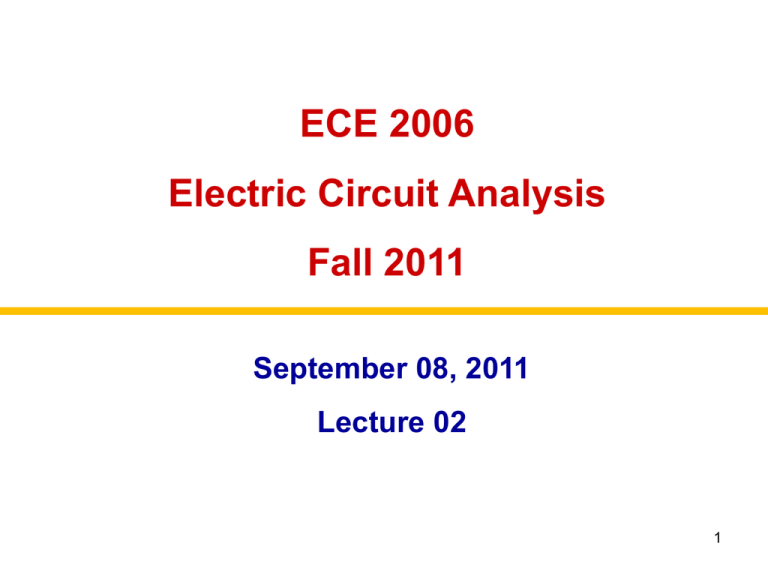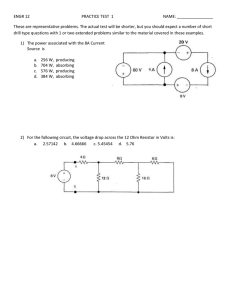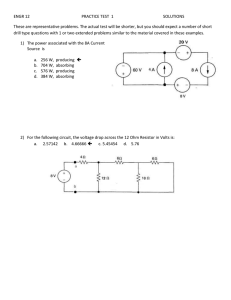V i
advertisement

ECE 2006 Electric Circuit Analysis Fall 2011 September 08, 2011 Lecture 02 1 For Your Information Course Webpage http://www.d.umn.edu/~jingbai/Electric_Circuit_Analysis_(ECE_2006).html You can find on the webpage: Lecture: course syllabus, lecture notes, homework (& solutions) Lab: lab syllabus (lab report format, grading matrix), lab instructions (11 labs) Tutorials: breadboard, resistor color code, Pspice (download site and tutorial) For unit conversion, you can learn more at http://physics.nist.gov/cuu/Units/units.html Lab TA: Tiger Qian, office hour: 3-4PM, Monday 2 Lab 1 Digital Multi-meter • Lab instructions • • Available online Print out and read before Lab • MWAH 391, 4:00 – 7:00 pm, next Monday or Wednesday (Sept 13/15) • Work in pairs (group of 3 if odd number) • • Group data, individual report Lab safety rules 3 Lecture Outline • Active and passive elements • Ohm’s Law • Kirchhoff’s current and voltage laws 4 Review: Electric Current Created by motion of charge I Measured by charge change rate, unit in A (amperes) dq 1C i= , 1A = dt 1s Convention on direction: flow direction of positive charges, opposite to the flow of negative charges 5 Review: DC Current and AC current Direct current (DC) I DC ( I ): current that remains constant with time Alternating current (AC) i AC ( i ): current that varies sinusoidally with time 6 Voltage Definition: electrical potential difference between two points of an electric circuit or electromotive force (emf) required to move the charge from one point to another point + a The potential difference between points a and b: vab= va-vb = dw/dq, vab b w: energy with unit in joules (J) q: charge with unit in coulombs (C) v: voltage with unit in volts (V) 1V=1J/C Polarity: “+” or “-” used to define the reference direction Voltage drop direction: from “+” polarity to “-” polarity The polarity can be defined by you 7 Power and Energy Power: the time rate of expending or absorbing energy, measured in watts (W): p=dw/dt=(dw/dq).(dq/dt)=vi Sign convention: i + a v b Current direction is the same as the voltage drop direction , P=vi i - a v + b When current direction is opposite to the voltage drop direction, P= - vi 8 Circuit Elements Circuit element is a mathematical model of a real device • Active element: p = vi <0, generating energy i.e., batteries, generators • Passive element: absorbing energy or storing energy i.e., resistors (p=vi>0, absorbing energy); capacitors and inductors (storing energy, sign of power depends on the initial condition) 9 Active Element The most important active elements are voltage and current sources • Independent sources v + - • Dependent sources + V i - Independent voltage sources Independent current sources v + - Dependent voltage source, VCVS or CCVS i Dependent current source, VCCS or CCCS 10 Example of Dependent Sources A B i A i 10i + - C + 5V - + - C 0.2i CCVS CCCS 11 Resistance Resistance is the physical ability to resist current. The circuit element used to model this behavior is the resistor, which is a passive element R Circuit symbol: Unit for R: Ω, 1Ω =1V/A l: length in m A: crosssectional area in m2 Resistance is dependent on the material property and physical dimensions of the resistor ρ: Material receptivity in Ω·m l R=ρ A 12 Ohm’s Law Statement: the voltage v across a resistor is directly proportional to the current i flowing through the resistor, i.e., v∝i v = iR v + - i V = iR 13 Short Circuit and Open Circuit v = iR (0 ≤ R < ∞) (A)Short Circuit (SC) R=0→v=0 + i v=0 R=0 - (B) Open Circuit (OC) R=∞→i=0 + i=0 R=∞ - 14 Conductance Conductance G is the reciprocal of resistance R, i.e., 1 i G= = R v Unit of G: siemens (S) or mhos ( ) 1S=1/Ω=1A/V 15 Power Power: the time rate of expending or absorbing energy, measured in watts (W): p=dw/dt=(dw/dq).(dq/dt)=vi Instantaneous power for any circuit element: p(t)=v(t)i(t) The power delivered to a resistor is 2 v v = v 2G p = vi = v = R R 2 i p = vi = (iR )i = i 2 R = G 16 Branch, Nodes and Loops One node + - A branch is a single element such as a voltage (current) source or a resistor; A node is the point of connection between two or more branches; A loop is any closed path in a circuit 17 Elements in Serial and Parallel Two elements are in series if they exclusively share a single node Two elements are in parallel if they are connected to the same two nodes 18 An Example 4 1 5 2 3 6 Which circuit elements are in series? Which are in parallel? 19 Kirchoff’s Current Law (KCL) KCL: the algebraic sum of currents entering a node (or a closed boundary) is zero, i.e., N ∑i n =1 n =0 Algebraic sum: distinguished from arithmetical sum, the aggregate of two or more numbers or quantities taken with regard to their signs, as + or -, according to the rules of addition in algebra; 20 KCL (Cont’d) Derivation of KCL is based on the conservation of charge, i.e., N N N dqn = in = ∑ ∑ n =1 n =1 dt N ∑ dq n =1 n Example: n =1 dt n 0 = =0 dt = 0 , conservation of charge Define the currents entering the node are “+”, those leaving are “-” i2 i3 i1 i5 ∑ dq i4 i1 + i2 + (−i3 ) + i4 + (−i5 ) = 0 i1 + i2 + i4 = i3 + i5 The sum of currents entering the node is equal to the sum of the currents leaving the node. 21 Application of KCL iT i1 i2 iT = i1 + i2 + i3 i3 i2 i1 i1 = i2 22 Kirchoff’s Voltage Law (KVL) KVL: the algebraic sum of all voltages around a closed path (or loop) is zero, i.e., N ∑v m =1 + v2 - + v3 m =0 Define the voltage drops along clockwise direction are “+”, those opposite are “-” - − v1 + v2 + v3 − i4 + v5 = 0 - + v1 - + v5 - + v4 v 2 + v3 + v5 = v1 + i4 Sum of voltage drop=Sum of voltage rise 23




